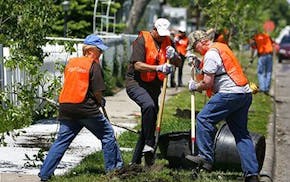The number of flu outbreaks in Minnesota schools dropped by more than half last week, and hospitalized cases dipped nearly 20 percent, raising the possibility that the H1N1 epidemic may be on the retreat, state health officials said Wednesday.
"I am optimistic that we have peaked," said Dr. Ruth Lynfield, Minnesota's state epidemiologist, who has been tracking the outbreak since April. "But we need several weeks of data to know for sure."
The encouraging signs emerged even as the Health Department announced four more flu-related deaths and the first two confirmed outbreaks in Minnesota nursing homes.
In the final week of October, 137 schools reported outbreaks of flu-like illness, down from 288 the week before, according to the Health Department. Those are schools where more than 5 percent of students were out sick, or more than three elementary-school children were absent from the same class.
Meanwhile, 182 people were hospitalized with confirmed cases of H1N1 last week, compared to 225 the week before.
The Health Department also tracks flu-like illness at 25 "sentinel" clinics around the state. Last week, only 3.5 percent of patients at those clinics had flu-like symptoms, down from 7.5 percent the week before and a high of 12.6 percent in mid-October.
"We certainly do have a number of indicators that influenza-like activity throughout the state is going down," Lynfield said.
Yet she and John Linc Stine, an assistant health commissioner, cautioned against reading too much into seven days of numbers. "While it offers some positive signs that we may have seen a peak, we don't know that right now," Stine said.
There are other signs, though, that the pandemic may be on the downswing. In the third full week of October, a record number of children poured into the two emergency rooms at Children's Hospitals and Clinics of Minnesota, with the Minneapolis emergency department topping 200 a day for the first time in its history, according to spokesman Brian Lucas. By last week, he said, the volumes were down 10 to 15 percent.
"From our perspective it's still too early to tell if this is a trend or just a fluctuation," Lucas said, adding that the numbers "are still 50 to 60 percent higher than we would see during a normal year at this time."
Lynfield noted that the flu may be increasing in some parts of the state, particularly northern Minnesota, even as it's easing in others. "There are geographical differences," she said.
In the past, flu pandemics have typically hit in waves that last several months, disappear and return for a second or third round. So even if the flu is abating now, it could come back again, Lynfield warned. That's one reason that officials are pushing ahead with plans to vaccinate as many Minnesotans as possible.
The Health Department released little information about the four people who died. Only three had confirmed cases of H1N1, or swine flu: a Hennepin County resident in his or her 50s; a Fillmore County patient in his or her 20s, and a Winona County patient in his or her 70s. All three had pre-existing medical conditions that put them at high risk, officials said.
The fourth victim was "an older adult" who also had underlying health conditions, Lynfield said. Although the patient most likely had the H1N1 strain, she said, the Health Department was not able to obtain a tissue sample for testing, so it's unconfirmed.
Officially, 15 Minnesotans have died with confirmed cases of H1N1, and Lynfield said the department is investigating additional deaths.
Until last week, the flu had been conspicuously absent from the state's nursing homes. But two long-term care facilities reported outbreaks the last week of October, officials said. They would not identify them by name or location.
Staff writer Bob von Sternberg contributed to this story. Maura Lerner • 612-673-7384

Yuen: Why do people forgive? It's messy, complex and 'the best form of self-interest'
How the Goo Goo Dolls learned the music biz from Minneapolis bands
